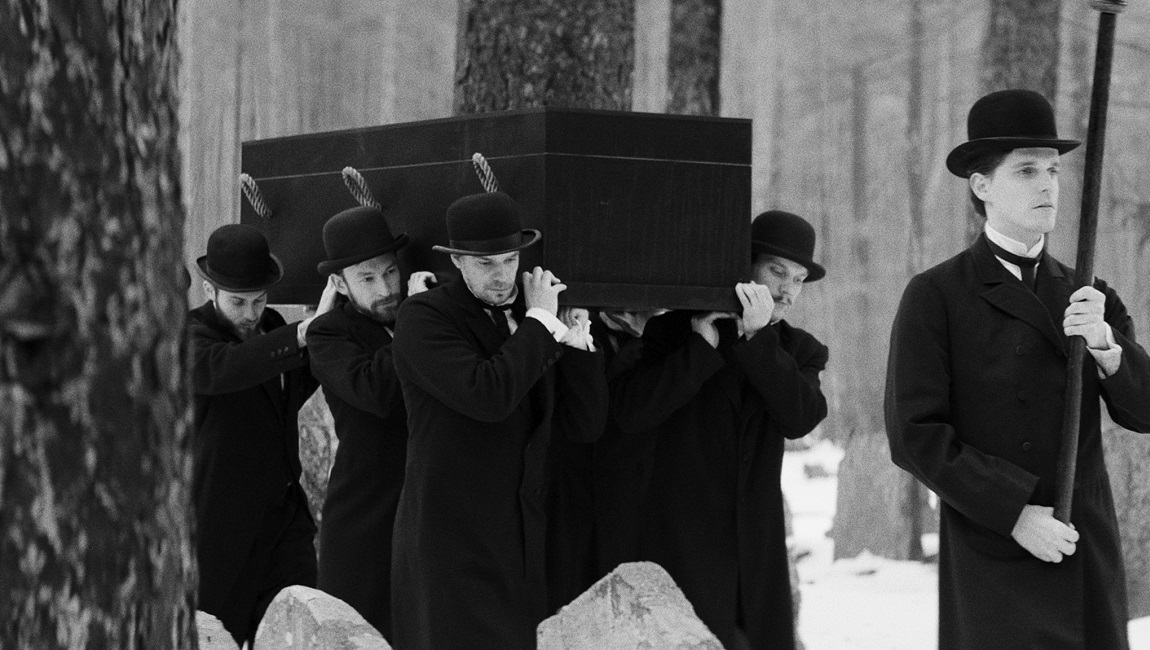The Year Before the War begins with an impressive sequence shot; in closeup, workers methodically cut huge blocks of ice out of a frozen lake. The camera pulls back to reveal a man whispering to frozen fish about death, before immediately plunging himself into the icy maw while the other workers look on, unfazed. The camera then tracks across the surface of the frozen lake to take in revelers cavorting in front of a sign that reads simply “1913” in burning numbers. With this, director Dāvis Sīmanis has declared that we are firmly in the realm of phantasmagoric allegory, like some absurdist mixture of Parajanov and Jancso rendered in luscious black and white. This is a film of cryptic symbols and slippery connections, legible in broad strokes but confounding in its pileup of early 20th Century signifiers. Set mostly in Riga, the capital of Latvia, with detours to Paris and Austria, the film plays like a kind of reverse Pilgrim’s Progress as it follows the tribulations of hapless hotel doorman, Hans (Petr Buchta). Seemingly content to his life as a simple, humble worker, Hans is soon mistaken for an anarchist terrorist named Petr Leton, and then proceeds, over the course of the film, to transform into his own doppelgänger.
Broken up into chapters, each delineated by the months of the year, Hans (or maybe Petr), crosses paths with a litany of historical giants; there’s Freud (Girts Kesteris), Lenin (Lauris Dzelzitis), and Trotsky (Gints Gravelis), as well as portrayals of Wittgenstein, Kafka, Proust, E. T. A. Hoffmann, Oswald Spengler, and others. There’s also a spy named Alma (Inga Silina), who Petr (or maybe Hans) falls in love with, their romance providing a kind of skeletal narrative that links together otherwise scattered vignettes. It’s worth noting that not every player of this extensive roster is immediately identifiable, nor is it clearly elucidated exactly how their political or artistic philosophies directly or indirectly shape this peculiar narrative. Hans is certainly a Josef K.-like figure, stumbling around in a secret world he doesn’t understand, full of rules and structures that elude him, perhaps suggesting that the lead up to the eve of WWI was unknowable and immutable. Both Lenin and Freud are portrayed as wide-eyed lunatics who cackle maniacally. Hoffman’s tales of automatons make an appearance at a nudist colony, while Sīmanis also sprinkles in references to Dostoyevsky and visual nods to Dali and Ingmar Bergman. It would all be maddening if it wasn’t so fascinating to look at, and frequently funny to boot. Sīmanis creates beautiful, claustrophobic compositions, trapping figures in architectural spaces and turning god’s eye views of cityscapes into inescapable mazes. It’s not entirely clear what this discursiveness all adds up to, beyond maybe a frustrated shrug, but it’s certainly symbolically meaningful that this cacophony of voices and conflicting beliefs led inexorably to worldwide warfare. Ultimately, there’s something universal about Hans, eventually transformed into a military leader overseeing tribunals and levying punishments to townspeople under the watchful eye of a giant Lenin portrait. War changes everything, and makes monsters of us all.
Published as part of IFFR 2021 — Dispatch 2.







